|
||||||||||
|
|
||||||||||
|
||||||||||
|
|
||||||||||
Sir Hiram Maxim, July 1894
Hiram Stevens Maxim (1840-1916) was born in the United States but spent most of his adult life in England. There, he developed what is probably his most famous invention, the Maxim machine gun that was widely used by the British and other European armies prior to World War I. This creation earned Maxim a great fortune that he used to investigate a variety of other fields, including manned aircraft. Maxim began these efforts in the late 1880s, and he had succeeded in constructing a massive biplane test rig by 1893. This rig was not a true flying machine, but a test vehicle intended to measure the lifting force generated by different kinds of wings. As a result, the apparatus used two restraining rails, similar to train tracks, to prevent the machine from climbing more than a few feet off the ground. Even so, the test rig was an enormous contraption, even by today's standards. With a wingspan of over 100 ft (30 m) and weighing 7,000 lb (3,175 kg), the machine was powered by two giant 180 hp steam engines turning two propellers over 17 ft (5 m) in diameter.
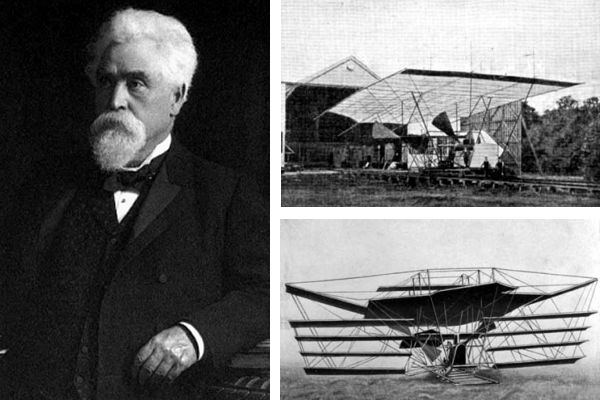
Although the machine was never intended to fly, the test rig did become airborne on 31 July 1894 during its third run. The apparatus, with Maxim and three other crew aboard, generated so much lift that it actually broke away from the restraining rails and careened uncontrolled for some 600 ft (185 m). The rig reached altitudes of up to 3 ft (1 m) before it crashed and damaged the vehicle. It was estimated that a force of 10,000 lb (45 kN) was probably generated to pull the rig off the track and keep it airborne.
The rig was later repaired, but used only to raise funds for charities and never again for aviation experiments. Despite his noteworthy accomplishment, Maxim lost interest in the project and the test rig was dismantled sometime in 1895. Maxim's test rig does deserve credit for achieving flight while under power, but the aircraft could not be controlled and the flight was not sustainable.
Clément Ader, October 1897
Clément Ader (1841-1926) was a French inventor whose primary interests included balloons, early electronic communication devices, and aviation. His most famous contributions to aeronautics were two remarkable aircraft known as the Eole and Avion No. 3. The overall design of the Eole was a monoplane inspired by a bat, and the vehicle was powered by a 20 hp steam engine turning a single propeller. Weighing about 1,100 lb (500 kg), the Eole had a wingspan of some 46 ft (14 m).
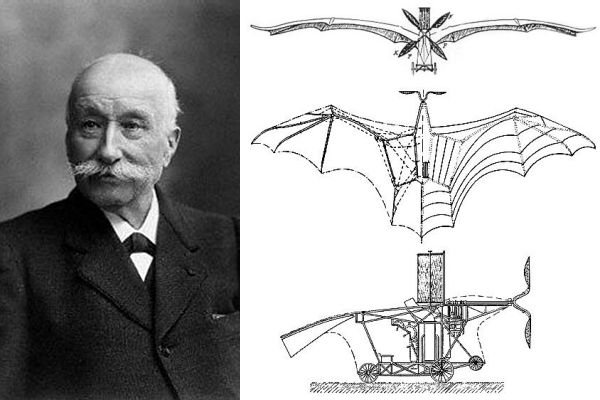
Ader claimed that he flew the Eole a distance of 160 ft (50 m) on 9 October 1890 while testing the craft on the estate of a friend near Paris. Unfortunately, the vehicle was overweight and underpowered and could do no better than bounce a few inches off the ground. In addition, the Eole possessed a fundamental design flaw--lack of an adequate control system--causing the plane to crash and become damaged beyond repair.
Nevertheless, Ader's flight was the first demonstration that a powered aircraft could in fact fly, and the success spurred the French military to fund the construction of a larger and more powerful vehicle of the same basic design. Ader's first attempt was known as the Avion II, but this craft was never completed. He instead focused his attention on the Avion III, another bat-wing monoplane but fitted with two 20 hp steam engines driving two propellers.
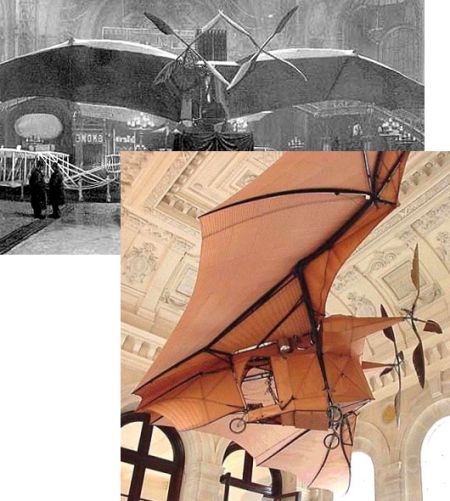
This prototype was ready for testing in October 1897 when two demonstration flights were given to the French military. The first attempt, on 12 October, resulted in several short hops, but the military officers present did not consider the performance to constitute flight. A second attempt was made two days later when the Avion's lack of control became readily apparent and the craft crashed after a few hops above the ground. This "flight" marked the end of Clément Ader's aeronautical experiments for the lack of success of the Avion III led the French Ministry of War to cancel further funding.
As the years went by, however, Ader's claims of success grew more extravagant. He even went so far as to maintain that he had flown nearly 1,000 ft (305 m) in the Avion III, a feat supported by two witnesses. Though these contentions could not be proven and were even refuted to some degree, Ader's creations were still two of the most significant contributions to the early years of aeronautics. Clément Ader is rightly considered to be the "Father of French Aviation," and his Avion III is an honored display at the Musée de l'air et de l'espace.
Augustus Moore Herring, October 1898
August Herring (1867-1926) was an American aviation enthusiast heavily involved in the glider experiments of Octave Chanute, one of the best known aviation pioneers of the late 1800s. Herring also briefly worked for Samuel Langley, who was the principal competitor to the Wright brothers. Herring's experiences with these two giants of American aeronautics inspired him to build and fly gliders of his own design at the Indiana Sand Dunes and St. Joseph, Michigan.

Much of Herring's work improved upon gliders he had earlier built along with Chanute, configurations largely inspired by the designs of Otto Lilienthal in Germany. These gliders typically included no control system other than shifting the weight of the pilot, who was suspended beneath the wing. Herring's attempt at powered flight came in 1898 when he mounted a 3 hp compressed air engine above the lower wing of one of his biplane gliders. This engine powered two propellers, one in front of the engine and the other behind. Weighing about 90 lb (40 kg), the craft had a wingspan of 18 ft (5.5 m).
Herring is reported to have flown his powered glider on two attempts. The first, which occurred on either 10 or 11 October 1898, is said to have traveled 50 ft (15 m). Herring also claimed a second flight ten days later that lasted about ten seconds and traveled 72 ft (22 m). While Herring's craft probably did fly with an engine aboard, the craft was not controlled and the flight was not sustainable. Moreover, the small engine was woefully underpowered and could only operate for 30 seconds at a time. At best, Herring's craft can be described as a glider that happened to be carrying an engine as payload rather than a powered aircraft.
Gustave Whitehead, August 1901
Gustav Weisskopf (1874-1927) was born in Germany but emigrated to the US and anglicized his name to Gustave Whitehead in 1895. His interest in aviation began in Germany, but Whitehead's most significant experimentations commenced in America. By 1898, he was living in Pittsburgh, Pennsylvania, where he had built his first steam-powered airplane. A single witness reported that Whitehead not only flew this aircraft in 1899, but that the trip covered some 2,500 ft (765 m) and that the witness was aboard as a passenger. Aside from this witness account, however, there is no evidence to support the rather fanciful story, and it has been largely discounted.
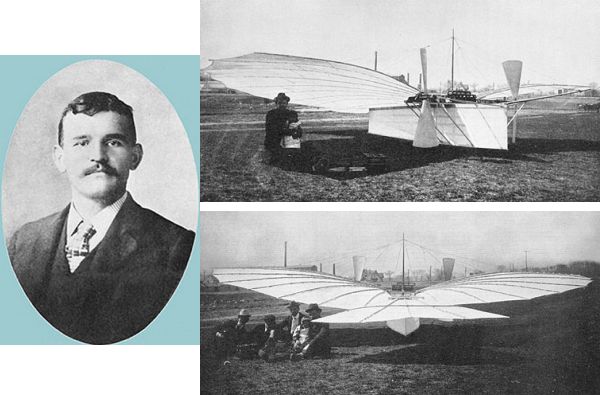
Nonetheless, Whitehead's most credible claims were to lie ahead. Whitehead moved his family to Bridgeport, Connecticut, where he took a job as a mechanic around the turn of the century. There, he constructed his most famous aircraft, the No. 21. This vehicle was a rather elegant looking monoplane with the pilot seated in a fuselage shaped much like the hull of a boat. Power was supplied by a four cylinder gasoline engine turning two propellers, and the entire craft weighed about 800 lb (360 kg).
According to Whitehead supporters, his greatest success came on 14 August 1901 when Gustave is said to have made as many as four test flights of the No. 21. The first of these, supposedly conducted in the pre-dawn darkness, is claimed to have traveled over 2,500 ft (765 m). Another test is claimed to have covered 1.5 miles (2.4 km) and reached altitudes up to 200 ft (60 m). Supporters go on to say that two more flights were made aboard a new aircraft, the No. 22, on 17 January 1902--one traveling 2 miles (3.2 km) and the other 7 miles (11.3 km).
Unfortunately, the evidence to back up any of these rather extraordinary claims is sketchy, at best. The most ardent believers in Whitehead's accomplishments did not publish any of their claims until over 30 years after they are alleged to have occurred. By this time, only one eye witness could be found to corroborate the stories, and this individual had a financial interest in a book being written about Whitehead. A number of local newspaper articles describing the flights and written at the time they occurred have also been used to support Whitehead's claims, but a close inspection of these publications reveals details that are simply impossible to believe. Among these are stories about the plane being flown at night to avoid crowds and unmanned flights being conducted using sand bags as ballast. In addition, the articles are replete with phrases like "It was reported that..." which imply that the authors never actually witnessed any of the events they wrote about. Furthermore, not a single photograph of Whitehead in flight has ever been found, despite the numerous opportunities that should have been available to take one given his frequent flights detailed above. Whitehead's rather ridiculous defense in this regard was his contention that his planes flew up to 70 mph (115 km/h), which was so fast that no camera could photograph him! Perhaps the most telling evidence of all is the fact that his wife could not remember any instance of seeing her husband flying in one of his planes.
In more recent years, groups of Whitehead supporters have attempted to build and fly replicas of his planes in order to prove that he flew before the Wrights. While some of these craft have indeed managed to fly, they are not true replicas since they used modern propellers and lightweight, high horsepower engines that were unavailable to Whitehead. Moreover, Whitehead left behind no plans or letters describing the workings of his craft, so modern enthusiasts have had to recreate these vehicles from scratch based on nothing but a few photos and newspaper articles. Even if one accepts all of these limitations, the simple fact that a modern recreation of a Whitehead plane managed to fly does not prove that Whitehead himself was successful, at least before 1903.
Richard Pearse, March 1903
Richard Pearse (1877-1953) was a reclusive inventor from New Zealand who spent most of his life developing various mechanical devices at his remote farm. One of his greatest passions was aviation, and the numerous aircraft and related gadgets found around his property indicate that he devoted much time to this pursuit around the turn of the century. His best known creation was a rather diminutive airplane with a wingspan of about 23 ft (7 m) and powered by a 24 hp gasoline engine turning a single propeller. The pilot sat beneath the wing, much as on a modern ultralight. The aircraft also included a rudimentary aileron-like system plus simple rudder and elevator control surfaces, but the craft must have been quite difficult, if not impossible, to control due to the placement of these surfaces.
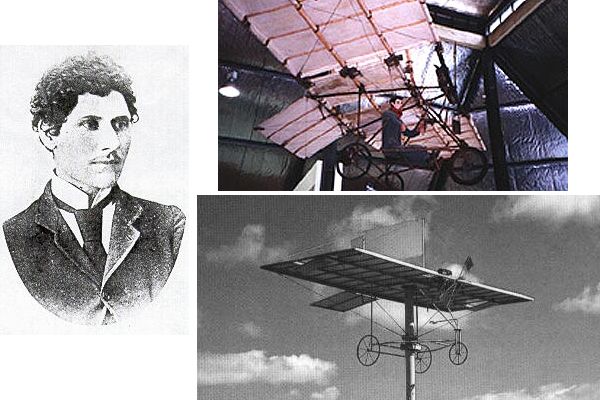
No one seems to be quite sure when the aircraft first flew. Some sources say as early as 1901 while most indicate March of 1902 or 1903. Accounts of the results of this first flight are even more confused, with claims of the vehicle traveling anywhere from 150 to 1,200 ft (45 to 365 m). Additional flights were also said to have occurred in May and July of 1903, perhaps covering up to 3,000 ft (915 m) and reaching altitudes over 30 ft (9 m).
However, there is little or no evidence to support these claims. Most of the tales of Pearse's accomplishments never left the confines of the small farming community in which he lived until decades later. Whatever eye witnesses might have existed were long gone by that point, and the stories had become more legend than verifiable fact. Pearse himself even contradicts the claims of his success in two letters published in 1915 and 1928. There, Pearse states that he did not become involved in aviation until 1904 and that he never achieved a true flight in any of his aircraft. Pearse continued his aeronautical experimentation and received a patent in 1906, but he was never able to achieve more than a few powered takeoffs and hops during testing.
Preston Watson, summer 1903
Preston Watson (1880-1914) was a Scottish aviation enthusiast who was building and flying manned gliders in the early 1900s. His most interesting contribution to the young field was a new method of control called the "parasol plane." This device was a small second wing placed above the main wing that could be rocked back and forth causing the plane to bank and turn. Watson incorporated this device into his later gliders as well as powered aircraft.

A great deal of speculation exists regarding when Watson built and flew his first powered plane. Local residents recalled witnessing Watson making short flights of an aircraft powered by a single engine between 1903 and 1904, but no one could remember any exact dates. What is known for sure is that Watson flew after the Wrights, and he built two improved versions of his original powered aircraft. His second plane made use of a 30 hp gasoline engine while the third employed a 60 hp engine. It is said that these two machines were flown frequently in the years before World War I. During that conflict, Watson volunteered for the newly formed air wing of the Royal Navy and was killed when his aircraft exploded in flight.
Despite the insistence of Watson's fans, however, there is again no solid evidence to support the claim that he flew before the Wrights. Watson himself never even made any such contention, and the documentation that does exist seems to suggest he did not fly earlier than 1905.
Karl Jatho, August 1903
Karl Jatho (1873-1933) was an inventor, civil servant, and entertainer from Hanover, Germany. Having become interested in aviation, Jatho set out to build a powered aircraft in the early 1900s. He patterned his unusual wing design after the Zanonia seed, a shape known for its long and stable gliding ability. The aircraft reportedly began as a triplane, but was quickly reduced to a biplane layout once testing began. Power was provided by a single 10 hp engine driving a two-bladed pusher propeller.
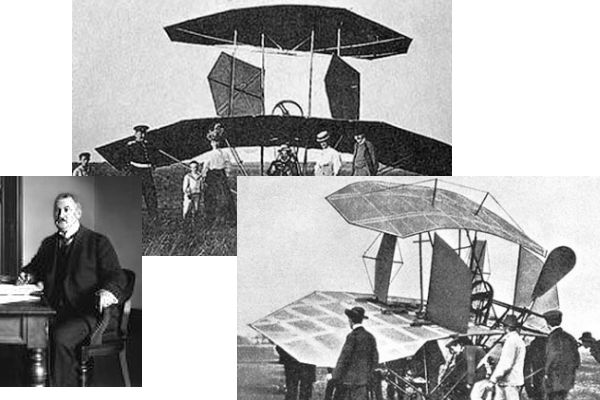
The first flight of Jatho's biplane is said to have occurred on 18 August 1903, being notarized by four witnesses. This short hop cruised just inches above the ground and covered about 60 ft (18 m). Additional flights are also said to have occurred between August and November, the longest covering about 200 ft (61 m) and climbing as high as 10 ft (3 m) in altitude. However, Jatho was rather dissapointed in the performance of his craft, which was limited both by an underpowered engine and a flat, planar wing cross-section as opposed to the curved airfoils used by the Wrights. He eventually gave up on his plane and wrote, "in spite of many efforts, cannot make longer or higher flights. Motor weak." While most historians credit Jatho with a powered flight, his craft's control system was inadequate and the flight not sustainable. He later went on to build and fly a successful aircraft in 1909. Jatho also opened a flight school and aircraft factory, but neither was profitable.
Summary
While each of the pioneers described above can make a serious claim to being the first to fly, the ultimate determination really comes down to how you decide to measure success. It is not in question whether any of these innovators had a keen insight into aviation, for they all designed and built amazing creations that pushed the bounds of existing knowledge. Some even managed short hops into the air, but how do we decide what constitutes flight and what doesn't? The criteria most researchers have applied is a craft that could only sustain its flight thanks to the power of its engine and was fitted with a control system allowing the pilot to maintain his course. The flight must also be well-documented by first-hand witnesses, and perhaps most important of all, the flight must be repeatable. The accomplishments of the pioneers described above all fail on at least one of these criterion whereas the Wright Flyer does not. Most of these men even admitted themselves that they had not accomplished what the Wrights had done.
Regardless, I think the most important lesson to learn from this discussion is that the Wrights did not step into
a vacuum and miraculously succeed in doing what no one thought possible. Many aviators around the world believed
that heavier-than-air flight was inevitable, and the knowledge they gained through trial and error was vital to
those who followed. The lessons they learned became the blocks on which the Wrights built the world's first
controllable and sustainable aircraft.
- answer by Jeff Scott, 18 January 2004
Related Topics:
What are the most significant events in the history of aviation and space flight?
Read More Articles:


|
Aircraft | Design | Ask Us | Shop | Search |

|
|
| About Us | Contact Us | Copyright © 1997-2023 | |||
|
|
|||